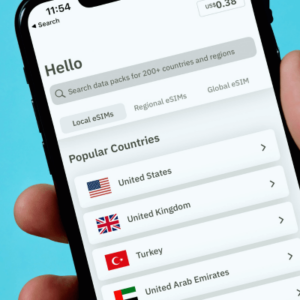This shift promises a lot of benefits, from streamlined connectivity to enhanced security, but it’s not without its challenges. In this article, we delve into the intricacies of eSIM implementation, explore the obstacles faced, and highlight potential solutions to ensure a smooth transition for consumers and businesses alike.
Understanding eSIM Implementation and Technology
What is an eSIM?
An eSIM, or embedded SIM, is a small chip embedded within a device that can be programmed to work with various mobile carriers. Unlike traditional SIM cards that need to be physically removed and replaced when switching networks, eSIMs can be activated or reprogrammed through software updates. This flexibility offers unprecedented convenience for users who frequently travel or switch service providers.
How Does eSIM Work?
eSIM technology leverages remote provisioning, allowing users to download multiple carrier profiles to a single device. This means you can switch between networks without needing a new physical SIM card. The entire process, from activation to switching carriers, can be managed directly from the device settings, making it highly user-friendly.
- Leverages remote provisioning:
- Allows users to download multiple numbers and carrier profiles to a single device.
- Enables network switching without a new physical SIM card:
- Users can switch between networks seamlessly.
- Managed directly from device settings:
- Activation
- Switching carriers
- Highly user-friendly process.

Key Benefits of eSIM Implementation
Seamless Connectivity Across Borders
One of the standout advantages of eSIM technology is the ease of connectivity it offers, particularly for international travelers. Instead of hunting for local SIM cards upon arrival in a new country, users can simply switch to a local carrier profile already stored on their eSIM. This feature makes global roaming affordable, as it avoids expensive roaming charges.
Enhanced Device Design and Security
The removal of a physical SIM card slot allows for more device designs and innovation. Manufacturers can utilize the saved space for larger batteries, additional features, or more streamlined aesthetics. Moreover, eSIMs are less susceptible to loss or theft, making them a more secure option for users concerned about data privacy and security
Improved Customer Experience
The traditional process of changing SIM cards can be cumbersome and time-consuming. With eSIMs, users can switch carriers with just a few taps on their devices. This ease of use translates to better customer satisfaction and fewer support inquiries for network providers.
Challenges in eSIM Implementation
Technical Compatibility Issues
Despite the numerous benefits, eSIM implementation faces significant technical compatibility challenges. Not all devices currently support eSIMs, and not all network providers offer eSIM services. This fragmentation can lead to a confusing landscape for consumers and hinder the widespread adoption of the technology.
Regulatory and Compliance Hurdles
The regulatory environment poses another substantial challenge to eSIM implementation. Different countries have varying regulations regarding eSIM technology. For instance, some regions have strict requirements around data privacy and security, which can complicate the deployment of eSIM services. Navigating this regulatory maze requires careful planning and collaboration with local authorities.
- Varying regulations across countries:
- Different legal frameworks for eSIM technology.
- Stringent requirements in some regions:
- Data privacy
- Security
- Complicated deployment of eSIM services:
- Requires meticulous planning.
- Necessitates collaboration with local authorities:
- Ensures compliance with local regulations.
Consumer Awareness and Adoption
While eSIM technology offers clear advantages, consumer awareness remains relatively low. Many potential users are unaware of what eSIMs are and how they can benefit from them. This lack of knowledge can slow down the adoption rate, as users tend to stick with familiar technologies.

Solutions to Overcome eSIM Implementation Challenges
Enhancing Technical Interoperability
To address compatibility issues, industry stakeholders must work towards standardizing eSIM technology across devices and networks. This can be achieved through collaborative efforts among device manufacturers, network providers, and industry bodies. Establishing universal standards will ensure that eSIMs work seamlessly across different devices and carriers, simplifying the user experience.
Navigating Regulatory Landscapes
Manufacturers and service providers should engage proactively with regulatory bodies to harmonize eSIM standards globally. By advocating for unified regulations, companies can streamline the implementation process and reduce the complexity involved in complying with diverse legal frameworks. This collaborative approach will facilitate smoother rollouts and broader acceptance of eSIM technology.
Boosting Consumer Awareness in eSIM Implementation
Effective marketing campaigns and educational initiatives are crucial to increasing consumer awareness and understanding of eSIM technology. Highlighting the convenience, security, and flexibility that eSIMs offer can drive adoption. Tutorials, user guides, and informative videos can help demystify the technology and encourage users to make the switch.
Future Prospects for eSIM Implementation
As eSIM technology matures, we can expect broader support from device manufacturers and network operators. Continuous advancements in the technology will further simplify its implementation, making it a standard feature in mobile communication. The future of eSIM looks promising, with potential applications extending beyond smartphones to include tablets, laptops, wearables, and IoT devices.
Broader Device Support
Future iterations of devices are likely to come with built-in eSIM support, making the technology more accessible to a larger audience. As more manufacturers embrace eSIM, consumers will benefit from a wider range of compatible devices, enhancing the overall user experience.
Integration with IoT
The Internet of Things (IoT) ecosystem can significantly benefit from eSIM technology. Devices like smartwatches, fitness trackers, and connected home appliances can leverage eSIMs for seamless connectivity and improved functionality. This integration will drive innovation and open up new avenues for smart device usage.
Simplified Network Management in eSIM Implementation
For network operators, eSIM technology offers opportunities to streamline operations and reduce costs. Remote provisioning and management capabilities can simplify the process of adding new subscribers, reducing the need for physical infrastructure and support services. This efficiency can translate to cost savings and improved service delivery.
Conclusion
eSIM implementation holds the promise of transforming the way we connect to mobile networks. By addressing the challenges and leveraging the solutions discussed, the global adoption of eSIM technology can be accelerated, ultimately benefiting consumers and businesses worldwide. The future of mobile connectivity is here, and it’s embedded in our devices.
Ready to experience the future of connectivity? Start your journey with Teminal’s eSIM solutions and enjoy seamless, hassle-free mobile connections anywhere in the world. Click here to explore our partners and find the best eSIM plan for your needs today!



